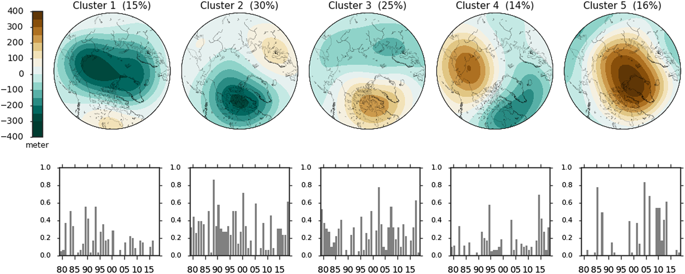npj Climate and Atmospheric Science ( IF 9 ) Pub Date : 2018-11-22 , DOI: 10.1038/s41612-018-0054-4 Marlene Kretschmer , Judah Cohen , Vivien Matthias , Jakob Runge , Dim Coumou

|
The stratospheric polar vortex can influence the tropospheric circulation and thereby winter weather in the mid-latitudes. Weak vortex states, often associated with sudden stratospheric warmings (SSW), have been shown to increase the risk of cold-spells especially over Eurasia, but its role for North American winters is less clear. Using cluster analysis, we show that there are two dominant patterns of increased polar cap heights in the lower stratosphere. Both patterns represent a weak polar vortex but they are associated with different wave mechanisms and different regional tropospheric impacts. The first pattern is zonally symmetric and associated with absorbed upward-propagating wave activity, leading to a negative phase of the North Atlantic Oscillation (NAO) and cold-air outbreaks over northern Eurasia. This coupling mechanism is well-documented in the literature and is consistent with the downward migration of the northern annular mode (NAM). The second pattern is zonally asymmetric and linked to downward reflected planetary waves over Canada followed by a negative phase of the Western Pacific Oscillation (WPO) and cold-spells in Central Canada and the Great Lakes region. Causal effect network (CEN) analyses confirm the atmospheric pathways associated with this asymmetric pattern. Moreover, our findings suggest the reflective mechanism to be sensitive to the exact region of upward wave-activity fluxes and to be state-dependent on the strength of the vortex. Identifying the causal pathways that operate on weekly to monthly timescales can pave the way for improved sub-seasonal to seasonal forecasting of cold spells in the mid-latitudes.
中文翻译:

平流层对欧亚大陆和北美洲极端气候的影响
平流层极涡可以影响对流层环流,从而影响中纬度地区的冬季天气。弱涡状态通常与平流层突然变暖(SSW)有关,已显示出增加发生冷风的风险,尤其是在欧亚大陆,但其在北美冬季的作用尚不清楚。使用聚类分析,我们发现在低平流层中存在两个主要的极帽高度增加模式。两种模式都代表一个弱极性涡旋,但它们与不同的波动机制和不同的对流层区域影响有关。第一种模式是区域对称的,并与吸收的向上传播的波活动有关,导致北大西洋涛动(NAO)为负相,并在欧亚大陆北部爆发了冷空气。这种耦合机制在文献中有充分的文献记载,并且与北部环形模式(NAM)的向下迁移一致。第二种模式是纬向不对称的,与加拿大上空的向下反射的行星波有关,随后是西太平洋涛动(WPO)的负相位以及加拿大中部和大湖区的冷天。因果网络(CEN)分析证实了与这种不对称模式相关的大气路径。此外,我们的发现表明反射机制对向上的波活动通量的确切区域敏感,并且取决于涡旋强度。查明每周到每月时间尺度上的因果关系,可以为改善中纬度地区的次季节到季节预报提供铺平道路。



























 京公网安备 11010802027423号
京公网安备 11010802027423号